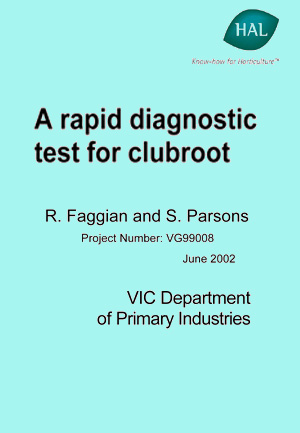|
A DNA-based forensic type test developed in Australia will provide vegetable growers with a valuable tool to help manage clubroot, one of the most costly diseases of brassica vegetables.
Clubroot is one of the most serious soil-borne diseases in the world, wiping out 10% of all brassica crops annually.
Control is difficult, expensive and often hard to target because there is no reliable and rapid detection method for Plasmodiophora brassicae, the organism that causes clubroot.
Designed for soil, water and plant material, this technology can be used to test fields to get a measure of potential yield loss due to clubroot, and to test water sources and nursery stock for possible contamination with the clubroot organism.
This 1999-2002 project delivered:
- robust, rapid, accurate diagnostic clubroot test
- new quantitative assays to predict crop disease before planting
- new tools to accelerate soil-borne pathogen research
- collaborative research between Natural Resources and Environment, VIC and Horticulture Research International, UK, to develop inexpensive on-farm test kits for clubroot and other soil-borne plant pathogens.
Authors
|
| Robert Faggian |
Sarah Parsons |
| Ian Porter |
Caroline Donald |
| Ann Lawrie |
|


Summary :
For the first time, a tool is available to the Australian brassica industry enabling the quantification of clubroot inoculum in soil.
This capability, together with information on factors such as pH, soil moisture content, varietal resistance, and others, will allow researchers to accurately predict the severity of disease in crops before they are planted.
Similarly, growers will be able to make informed decisions about potential disease management strategies, before planting.
The preliminary data presented here clearly demonstrates that real-time PCR can be used to accurately predict clubroot inoculum levels in the field.
The predicted risk categories correlate well with the actual clubroot scores observed in the corresponding field sites.
This is despite the fact that rudimentary dose-response data was used to assign the risk categories on the standard curve.
To gain greater accuracy, a comparison of different soil types would need to be carried in order to highlight the error that can be expected when assigning risk categories.
However, it may be preferable, and more practical for growers, to assign fewer risk categories, enabling a fail-safe integrated management option to be selected.
- The diagnostic test, which has proved to be quick, reliable, accurate and able to detect minute quantities of the Plasmodiophora in soil, water and plant samples, has attracted world-wide attention.
- This kit will enable growers to do preliminary on-farm tests which will indicate whether they need more accurate laboratory tests to determine the clubroot status of their farms.
- The clubroot diagnostic assay developed in Australia is seen as the ‘gold standard’ for clubroot detection worldwide and Australian expertise is considered vital to the successful development of an on-farm kit. In brief,
Recommendations :
- This project has developed the tools to enable growers to test their soil, water and planting material before planting.
- This will limit the spread of clubroot in recently infected areas and enable growers to select appropriate management strategies.
- Growers should use the diagnostic assay to form the basis of a testing regime for their farms and nurseries to ensure that the spread of clubroot is limited or stopped.
- The commercial diagnostic test can rapidly predict the presence or absence of clubroot in soil, water and plant tissue,
However, for quantitative prediction of disease to be accurate, further field monitoring is required – up until now, researchers have not had the tools at their disposal to measure soil-borne clubroot inoculum.
- This project has delivered the necessary tools, and they will accelerate soil-borne pathogen research.
It is important however that this situation be capitalised on, and the quantitative assay be commercialised.
Extensive field monitoring will therefore be conducted in the final year of the national clubroot program.
This data will be required to help validate that disease prediction is accurate in a range of soil types and under a range of climatic conditions.
- The final benefit to growers is likely to come from the development of an inexpensive field test kit for clubroot.
This work is currently underway in conjunction with Horticulture Research International (Wellesbourne, U.K.), a group with extensive experience in the development and use of on-farm pathogen test kits.
- Currently, Australian vegetable brassica growers are the only ones with commercial access to a clubroot diagnostic procedure. This competitive advantage should be maintained and exploited for as long as possible.
Acknowledgments :
This project was commissioned by Horticulture Australia Limited with funds frrom the Vegetable R&D levy and the Victorian State Government..
The Australian Government provides matched funding for all HAL’s R&D activities.
|

